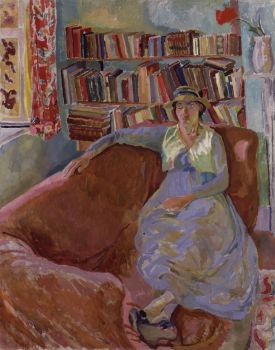Exhibition stirs Bloomsbury memories for Sussex art historian
By: Alison Field
Last updated: Tuesday, 3 May 2011

Vanessa Bell by Duncan Grant
A "revisitation of my past" is how University of Sussex art historian Professor David Alan Mellor describes 'Radical Bloomsbury', a new exhibition he has curated for Brighton Museum and Art Gallery.
His interest in the Bloomsbury group artists began when he was taught by Quentin Bell - a professor of art history at Sussex from 1967 until 1976 and the son of artist Vanessa Bell. He suggested his students have tea with artist Duncan Grant at Charleston Farmhouse, the home Grant once shared with Bell and their intellectual coterie.
"Grant was in his eighties at this point, but he was incredibly funny and witty," remembers Professor Mellor. "He had always been very personable - Matisse and Picasso had liked this spry little Scottish guy who was always laughing.
"I have curated exhibitions since the 1970s to do with people like Francis Bacon, and a lot of photography and pop art displays. For me, this exhibition is a revisitation of my past, and where it all started."
Some 80 works by Duncan Grant and Vanessa Bell have been gathered for the show, which tracks the artists' development from their early sketches in 1905 through to 1925.
The exhibition demonstrates how they were among the earliest British artists to look at new developments in European art, such as French Post-Impressionist practices, and the importance of their role in modernising British art.
Vanessa Bell was the sister of Virginia Woolf, one of the greatest modernist writers. Their home in London's Fitzroy Square was the hub of what became known as the Bloomsbury Group, with young intellectuals meeting to discuss politics, sexual attitudes and issues of the day. (The exhibition has a video display of notes from Woolf's letters and diaries of the time.)
Grant, born in 1885, was the son of a Scottish army officer and spent the first nine years of his life in India. Many of the works, such as Bathing (1911), show these early Eastern influences. He studied art in Paris and then moved to Bloomsbury in London, where he too became a regular at the home of Virginia Woolf and Vanessa Bell.
The exhibition includes loans from major galleries such as the National Portrait Gallery and the Victoria & Albert Museum, as well as private collectors such as rock star Bryan Ferry.
The final gallery of the exhibition focuses on their domestic lives. Decorated kitchen cupboards hang alongside portraits of close friends and family, including a painting by Vanessa Bell of Virginia Woolf knitting, and one of Bell at Charleston by Duncan Grant.
"As a group, Bloomsbury could be very independent," says Professor Mellor. "They were their own micro-society, which could be very welcoming but at the same time it could exclude people. A lot of people either love or hate their work."

